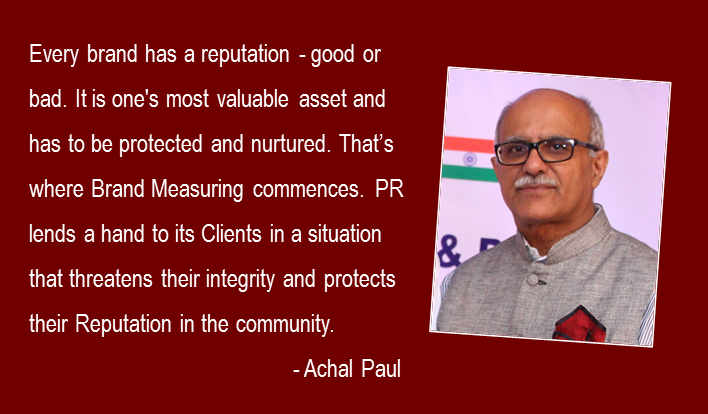Public Relations professionals help a business or individual to build a positive public perception through various unpaid or earned communications, including traditional, social media and in-person engagements.
As every brand has a reputation – good or bad. It is one’s most valuable asset and has to be protected and nurtured. That’s where Brand Measuring commences. PR lends a hand to its Clients in a situation that threatens their integrity and protects their Reputation in the community. If one doesn’t report the outcome of PR Campaigns, how can one Evaluate and start further working on it in order to improve? However, Public Relations allows the Brand to do SWOT Analysis, which assists in knowing the exact status of Brand in the respective Industry.
Appended below are few methods to Assess Public Relations Performance:
Social Media Monitoring and Measurement: Social Media has become a Key Player with regards to PR. Large numbers of companies choose to reach wider audience by taking this path of Social Media. It is very important to evaluate the effectiveness of the Social Media platforms (Facebook, Linkedin, twitter, Instagram, Youtube, Pinterest). This can be monitored through number of likes, comments, re-tweets, replies and sharing of particular message/page, displayed on the social media site of the Company. With the help of successful Campaign, which has been strategically planned for Social Media, there at times the probability is to get converted to a Business or any Association between the two or more Brands.
Market Survey & Public Opinion: Research is paramount to tracking a PR Campaign’s Achievement. Before starting the PR campaign, it is necessary to conduct a Survey in the respective Markets to see if the Brand is known or not. This will also aid in knowing if the Target Audience is aware about the offerings of the Brand.
Media Monitoring: Media Monitoring is the act of tracking topics across the media universe (print, online, social media, electronic and web electronic channels). In another words Media Monitoring is listening to who’s saying what about your Brand, your Competitors, your Industry, and any other Topic that’s important to you and your operations. Some metrics to monitor comprise of the number of articles secured in target titles and audience reached. Furthermore, conducting Quantitative Measurement, consider qualitative outcomes to analyse the content of the coverage. Were key messages included? Was the tone of the article positive? What Share of Voice did your Brand receive versus Competitors? Such elements determine not just how much coverage your brand has received but also whether the coverage was valuable. Thereafter, measuring the effectiveness of PR activity depends on having solid PR objectives. To have the utmost impact on Business results, PR Measurement must determine its return on efforts and investment. It must also identify where campaigns can be improved.
Website Traffic: Website Traffic Monitoring is the excellent way to evaluate PR Professionals performance. Before and after a Campaign launch, monitoring web traffic helps determining the success of the PR campaign. The number of visitors rising enlightens part of the story. Monitoring website traffic can be done easily with the help of Google Analytics. This tool assists its users to drill down into web traffic by analysing demographics like age group, location and ensures if the message has been conveyed to its target audience. In addition, back links are can also be used in coverage to improve website traffic and can upsurge the popularity with both search engines as well as its viewers.
To add further more to it, PR Calculation is one more metric, which plays pivotal role in Public Relations measurement and monitoring. It depends on the following:
Behavioral impact: It is the most important PR outcome to consider because it directly reflects the success of a campaign. How many customers called to inquire about your products or services? Are more people recommending your brand than before? Are you generating more sales? Is your site receiving more traffic from media placement, and how many of those visitors taking action (like purchase, call your customer support number, etc.)?
Growth: As a result of everything mentioned above, in an ideal world you should experience growth that doesn’t reference flash traffic to your site. If one is not selling anything (for example social startups) one should see more user registrations, and unique user growth. Maybe more app downloads if that’s what your business does. Product sales, if it is an e-Commerce and you had a concrete campaign based on a product launch. No matter how you look at it, growth means customer or user retention and revenue growth where this metric applies. If a PR campaign doesn’t have this outcome, it has failed.
Lastly, there were times when PR ROI (return on investment) was difficult to quantify are long gone. In fact, Big Brands have been successfully measuring the ROI of Public Relations for some time now. While many still consider ROI in financial terms (the amount of money totaled from Public Relations Campaigns after subtracting the costs), that calculation does not prove effective most of the time. But, many other elements can be considered to calculate return on PR investment. Return on Investment is essential for every business.
Earlier, the main measurement criteria were the quantity of coverage, channel of delivery and media type. Other factors included type of mention (feature or exclusive), whether competitors were also mentioned, source credibility, and popularity. Some factors apply online as well. Nowadays, tracking PR ROI also engages in measuring social media ROI, and measuring outcomes is the most important aspect of this equation.
While there is still no mathematical equation to measure success in Public Relations, but one might still have a fair idea of the PR’s success rate and ROI through the above metrics.



It’s really great to know so much about PR role in any industry.
Regarding the PR ROIs, what happens when an ad campaign is also run with a PR campaign? How to separate their ROIs?